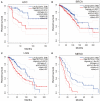Regulatory roles of copper metabolism and cuproptosis in human cancers
- PMID: 37035162
- PMCID: PMC10076572
- DOI: 10.3389/fonc.2023.1123420
Regulatory roles of copper metabolism and cuproptosis in human cancers
Abstract
Copper is an essential micronutrient for human body and plays a vital role in various biological processes including cellular respiration and free radical detoxification. Generally, copper metabolism in the body is in a stable state, and there are specific mechanisms to regulate copper metabolism and maintain copper homeostasis. Dysregulation of copper metabolism may have a great connection with various types of diseases, such as Wilson disease causing copper overload and Menkes disease causing copper deficiency. Cancer presents high mortality rates in the world due to the unlimited proliferation potential, apoptosis escape and immune escape properties to induce organ failure. Copper is thought to have a great connection with cancer, such as elevated levels in cancer tissue and serum. Copper also affects tumor progression by affecting angiogenesis, metastasis and other processes. Notably, cuproptosis is a novel form of cell death that may provide novel targeting strategies for developing cancer therapy. Copper chelators and copper ionophores are two copper coordinating compounds for the treatment of cancer. This review will explore the relationship between copper metabolism and cancers, and clarify copper metabolism and cuproptosis for cancer targeted therapy.
Keywords: cancer; cancer therapeutics; copper; copper complexes; copper metabolism; cuproptosis.
Copyright © 2023 Wang, Jin, Zhou, Dong, Ji, An, Wang, Luo and Luo.
Conflict of interest statement
The authors declare that the research was conducted in the absence of any commercial or financial relationships that could be construed as a potential conflict of interest.
Figures



Similar articles
-
Copper homeostasis and cuproptosis in tumor pathogenesis and therapeutic strategies.Front Pharmacol. 2023 Sep 12;14:1271613. doi: 10.3389/fphar.2023.1271613. eCollection 2023. Front Pharmacol. 2023. PMID: 37767404 Free PMC article. Review.
-
Cuproptosis: Unraveling the Mechanisms of Copper-Induced Cell Death and Its Implication in Cancer Therapy.Cancers (Basel). 2024 Feb 2;16(3):647. doi: 10.3390/cancers16030647. Cancers (Basel). 2024. PMID: 38339398 Free PMC article. Review.
-
Cuproptosis: A novel therapeutic target for overcoming cancer drug resistance.Drug Resist Updat. 2024 Jan;72:101018. doi: 10.1016/j.drup.2023.101018. Epub 2023 Nov 11. Drug Resist Updat. 2024. PMID: 37979442 Review.
-
Cuproptosis in cancers: Function and implications from bench to bedside.Biomed Pharmacother. 2024 Jul;176:116874. doi: 10.1016/j.biopha.2024.116874. Epub 2024 Jun 7. Biomed Pharmacother. 2024. PMID: 38850661 Review.
-
Strategies to combat cancer drug resistance: focus on copper metabolism and cuproptosis.Cancer Drug Resist. 2025 Mar 26;8:15. doi: 10.20517/cdr.2025.41. eCollection 2025. Cancer Drug Resist. 2025. PMID: 40201308 Free PMC article. Review.
Cited by
-
Exploring Copper's role in stroke: progress and treatment approaches.Front Pharmacol. 2024 Sep 26;15:1409317. doi: 10.3389/fphar.2024.1409317. eCollection 2024. Front Pharmacol. 2024. PMID: 39391696 Free PMC article. Review.
-
Targeting cuproptosis with nano material: new way to enhancing the efficacy of immunotherapy in colorectal cancer.Front Pharmacol. 2024 Dec 3;15:1451067. doi: 10.3389/fphar.2024.1451067. eCollection 2024. Front Pharmacol. 2024. PMID: 39691393 Free PMC article. Review.
-
GLS as a Key Cuproptosis-Related Gene in Periodontitis: Insights from Single-Cell RNA Sequencing.Int Dent J. 2025 Apr;75(2):1360-1369. doi: 10.1016/j.identj.2024.10.001. Epub 2024 Oct 20. Int Dent J. 2025. PMID: 39428264 Free PMC article.
-
Editorial Commentary: Copper Homeostasis in Neurodegenerative Diseases.Curr Med Sci. 2024 Feb;44(1):244-245. doi: 10.1007/s11596-024-2841-y. Curr Med Sci. 2024. PMID: 38393531 No abstract available.
-
Role of copper chelating agents: between old applications and new perspectives in neuroscience.Neural Regen Res. 2025 Mar 1;20(3):751-762. doi: 10.4103/NRR.NRR-D-24-00140. Epub 2024 May 13. Neural Regen Res. 2025. PMID: 38886940 Free PMC article.
References
Publication types
LinkOut - more resources
Full Text Sources

